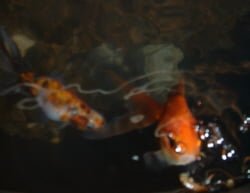Oxygen Deprivation leads to anoxia
Oxygen deprivation is common with goldfish. Goldfish that have been deprived of oxygen suffer from a condition known as anoxia; caused by oxygen deprivation; causing organs to shut down. Goldfish are the highest level of life form that are known to survive without oxygen for long periods of time; up to 24, even 36 hours
The fish in the photo below are suffering from oxygen deprivation, gasping at the surface in an attempt to take in oxygen. It doesn’t work. If you look closely, you see hemorrhaging on the orange fish around the gill plate
Goldfish gasping at surface
Causes for oxygen deprivation may be low pH levels, and or not enough surface action, combined with a covered aquarium and we have a recipe for disaster. Referred to as a pH crash; when pH levels decline rapidly into the danger zone; fish can and do die suddenly. Most of these fish could be easily revived if the goldfish keeper knew what to do
Your freshwater source has a natural pH which you should have tested to make sure it falls in the comfort zone; 7.4 pH to 8.4 ppm with the higher side of the zone preferred. In simple terms, pH (potential of hydrogen) is a combined measurement of (KH) carbonate mineral and oxygen. Carbonate mineral gives water the ability to support life, so we start by measuring this mineral and buffering if necessary
Goldfish yawning
The comfort zone for KH is 70 to 120 ppm, but again, the higher side of the zone is preferred
Use bicarbonate of soda to increase KH levels; start by premixing 1/8 teaspoon (per 10 gallons of water) to freshwater before a water change. After returning freshwater, wait for a good half hour and then test KH again. If lower than the 120 ppm goal, pull one gallon of tank water, premix another eight teaspoon and pour all around slowly, mixing with your hand as you do so. Continue with this process until the desired amount is achieved
Once the KH levels are up to 120 ppm, test pH. If the desired reading is 8.4 ppm or close to it. If it’s much lower, push a pitcher deep into the aquarium or pond water, filling it; pour back in; repeat this action for a good five to 10 minutes. Test pH and repeat pitcher method if necessary. If your KH reading is at 120 ppm, your pH have the potential of rising to 8. 4
Some KH testers test low. If your tester reads 120 ppm, but the pH levels are still low, take a sample of your tank and tap (to compare the two) to the pet shop for a free test, or contact your local water service for carbonate mineral readings
To support life; water must have a reading above 6.ppm however, a reading this low is close crashing, and killing the fish
Re oxygenation
If increasing pH level doesn’t help your fish, the following therapy may
Scoop your fish up in an appropriately sized container, and place it (open) in the refrigerator for two to three hours. Remove container and use tank water to replace the cold water in the container, exchanging one cup at a time

During recovery period, reduce aquarium of pond temps to 64f. This can be accomplished by using chilling tank water in the fridge; pour in all around slowly; refill and repeat. Use colder water with your fresh water change; crank up the air conditioner; point a fan at the tank
All rights reserved
Author: Brenda Rand